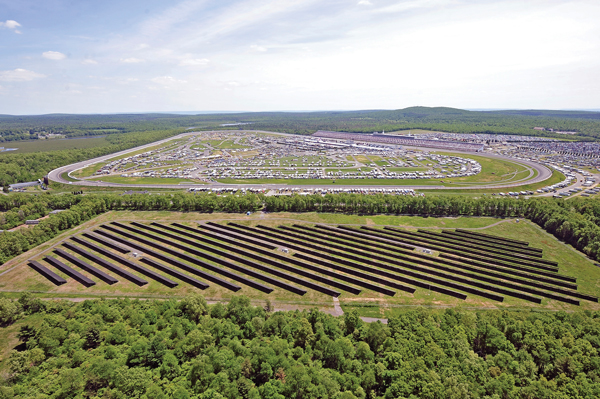When I was added to SBJ’s “50 Most Influential in Sports Business” list last December, I viewed that as much more than a personal accomplishment. Most importantly, I saw it as an affirmation that responsible environmental stewardship was now a mainstream feature of the sports industry, embraced by league officials, team owners, venue managers, athletes and sponsors alike.
The growth of the sports greening movement has evolved not a moment too soon. Global temperatures continue to climb: every month this year has been the hottest on record. The temperature in India exceeded 123 degrees in May, and the heat index in Bandar Mahshahr, Iran — near the northern coast of the Persian Gulf — rose to a deadly 163 degrees. Climate change is creating environmental refugees throughout the world, with entire communities being
displaced in regions as diverse as Alaska and Louisiana. Species extinction is accelerating, water scarcity afflicts almost 3 billion people, and the destruction of rare high-conservation-value forests and savannahs grows daily.
The response to these ecological threats by the sports industry has been meaningful: Golf, tennis, surfers, sailors, NASCAR, MLB, the NBA, NHL, MLS, NFL, USTA, collegiate sports and even ESPN are now all substantially engaged in greening their game. The NHL’s first league sustainability report is being updated and other pro leagues are planning to follow with their own reports, as are teams, including the Cleveland Indians and the New York Yankees. Food donations, recycling, composting, energy efficiency and water conservation programs are expanding throughout the sports sector, and sports management programs in colleges are increasingly integrating information about more sustainable operations into their curriculum.
Some of the most promising greening work is taking place among food concessionaires: Both Aramark and Legends have established sustainable sourcing advisory boards, as it becomes increasingly clear that shifting to
 |
Pocono Raceway was set to play host to the Pocono Green 250 NASCAR Xfinity Series race this past weekend, which highlighted the track’s solar farm and other sustainability initiatives.
Photo by: Pocono Raceway |
healthier and ecologically preferable food options is meeting a growing market demand — and an urgent ecological need: agricultural impacts instigate some of the greatest pressures on our planet.
And the sports greening movement continues to grow globally. During the past two years I have been working with representatives from UEFA, European Professional Club Rugby, the French Tennis Federation, Formula E and other Europe-based sports organizations — and Burson-Marsteller — to create the soon-to-be-launched Green Sports Alliance-Europe. The Sports Environmental Alliance continues to grow in Australia.
Despite these promising trends, much work needs to be done. If you weren’t focused on this issue, you’d be hard pressed to identify how much good environmental work is going on in the sports sector. With some notable exceptions, including this year’s Super Bowl 50, the greenest ever, and Pocono Raceway’s Green 250 this month, outreach to fans about environmental issues by leagues and teams is underdeveloped.
Every sports fan knows about Stand Up to Cancer, Breast Cancer Awareness, and Habitat for Humanity, but why is outreach about what we can do to combat climate disruption entirely absent from sports venue and online messaging? Three-fifths of all animals used as pro-sports mascots are at risk of extinction in the wild, but you would never know that even at the venues that celebrate those mascots. More than 45 million Americans don’t have enough food to eat, including more than 15 million children, but how many fans know that the NHL requires all of its arenas to donate postgame uneaten food to charities? And why don’t all the other leagues and sporting events require and publicize postgame food donations as well?
 |
It is not only effective environmental education that is lacking from the sports greening movement. League-coordinated measurement of key environmental performance indicators — energy, water, waste — is being led by MLB, the NHL and NBA, to great effect. The world would benefit if the NFL, MLS and NASCAR developed those types of measurement programs as well. Developing these programs takes years of committed work, as MLB, the NHL and NBA can attest, but they are surely of great value.
One hundred and sixty billion pounds of food waste is produced in the United States every year. The Pittsburgh Pirates, the U.S. Open Tennis Championships, the New York Yankees, AT&T Park, Safeco Field and numerous other venues achieve extraordinarily high waste diversion rates, in large part due to their commitment to food waste composting, but the fact remains that most food waste produced by sporting events still goes to the landfill, where it decomposes into methane, a greenhouse gas pollutant 60 times more potent than carbon dioxide.
The Defense Department and other U.S. government agencies have listed global climate disruption as a threat to our national security. Climate induced conflicts are already occurring, with some of the greatest threats located in the politically volatile Middle East. Sports routinely and publicly celebrates support for our troops, as we all should. So why the in-venue, on-screen silence about ways to address climate change, which might put our troops in harm’s way? Why the silence about disappearing lions, tigers, elephants, sharks and so many other sports mascots? With proven alternatives to landfilling like composting and food donations so well known, why is most food from sporting events still going to landfills?
Unlike sports, the ecological pressures we face is an ugly, destructive game. There is nothing fun about it. Fun and games attract people’s attention. While the sports greening movement has certainly taken off during the past decade, ecological destabilization is winning. But this is a life or death game. It is a game about the future of life on Earth. It’s a game we cannot afford to lose. Let’s step it up.
Allen Hershkowitz (allen@greensportsalliance.org) is president of the Green Sports Alliance.






